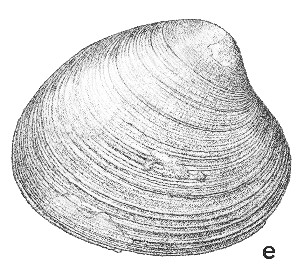
Revised descriptions of New Zealand Cenozoic Mollusca from Beu and Maxwell (1990)

 | Revised descriptions of New Zealand Cenozoic Mollusca from Beu and Maxwell (1990) | 
|
  (Pl. 28e): GS3619, S28/f8499, Whatarangi cliffs, eastern Palliser Bay, southern Wairarapa, early Tongaporutuan (GNS) |
Beu & Maxwell (1990): Chapter 13; p. 258; pl. 28 e.
Synonymy: Eumarcia (Atamarcia) thomsoni Marwick 1927, p. 630; Beu & Maxwell 1990, p. 258, pl. 28e; Atamarcia (Atamarcia) thomsoni, Maxwell 2009, p. 237
Classification: Veneridae: Tapetinae
Description: Size moderate for subgenus (62-70 mm long), nearly as high as long, weakly inflated, umbo at anterior quarter of length; shape roundly trigonal, umbones strongly protruding, posterior and particularly anterior margins sloping steeply, ventral margin weakly convex. Lunule a shallowly concave, narrowly heart-shaped depression below umbo, bounded by very low, narrow ridge in right valve and very faint groove in left valve. Sculpture of shallow, narrow, widely spaced, fairly regular commarginal grooves, on some specimens bounded by a very low, thin lamella at top of each groove; grooves are more obvious near anterior and posterior ends, central area polished. Variable in sculpture; a few specimens have regular, obvious commarginal grooves all over. Almost all specimens are closed, articulated shells with ligament preserved as prominent ridge behind umbones. Escutcheon a deep, short, triangular, steeply inclined face on right valve, but a much wider, longer, and more gently sloping area on left valve. Hinge narrow except for the short, wider, thicker cardinal area; right valve with similar, lamellar, short, high anterior and median cardinal teeth, and narrowly triangular, weakly curved, deeply grooved posterior cardinal; left valve with high, rather thick, lamellar anterior cardinal tooth, narrowly triangular, deeply grooved median cardinal, and long.-curved, narrow, posterior cardinal lamella separated from nymph by shallow groove; no anterior lateral teeth. Adductor muscle scars deeply impressed; clearly separated, deeply impressed, small, socket-like pedal retractor muscle scar beneath anterior end of hinge plate, above anterior adductor muscle scar. Pallial sinus with pointed apex and convex dorsal and ventral margins, extending one third valve length, directed at base of anterior adductor scar (i.e., horizontal). Interior of ventral margin smooth.
Comparison: Very similar forms to Atamarcia thomsoni (possibly several distinct species, but as the Palliser Bay population is variable in shape, inflation, and sculpture it is unclear at present how many species should be recognised) occur in near-shore to mid-shelf facies at Clifden, Southland (road cutting in Park Bluff Formation, Waiauan, several large specimens of a relatively low, consistently sculptured form; Lill Sand, Lillburnian, several specimens of a small form very close to typical A. thomsoni) and in the Oparara River area, Karamea district, southwest Nelson, Lillburnian and possibly Clifdenian (several excellent articulated shells of a short, highly inflated form, probably distinct from A. thomsoni). The description (above) of internal characters is based on the Clifden specimens.
No further material has come to light (to our knowledge) of A. summersae, which was based on a single complete, articulated Nukumaruan specimen from Gladstone, southern Wairarapa, so it is still conceivable that the holotype is a remanié Tongaporutuan specimen. However, it differs from all specimens of A. thomsoni we have seen in its taller outline, lesser inflation, weaker sculpture, and less well developed escutcheon, and seems likely to be a distinct Nukumaruan species. The older (and possibly ancestral) species A. curta (Altonian, North Otago and South Canterbury) differs from A. thomsoni in its lower, more oval form and its more prominent commarginal grooves. Maxwell (2009, p. 237) treated Atamarcia as a full genus, ranking Opimarcia Marwick, 1948 as a subgenus of it, but separating these from genus Eumarcia Iredale, 1925, which is smoother and has the lunule not impressed. We agree that these are two distinct genera.
Distribution: Lillburnian?-Tongaporutuan; Whatarangi cliffs, east of Hurupi Stream, eastern Palliser Bay, southern Wairarapa, early Tongaporutuan (type), common in a "Hurupi facies" shallow-water diverse molluscan assemblage; also other Wairarapa Tongaporutuan localities, several localities in "Tokomaru sandstone" facies inland from Tolaga Bay, north of Gisborne (Tongaporutuan), and Fox River, Westland (Waiauan).
Cite this publication as: "A.G. Beu and J.I. Raine (2009). Revised
descriptions of New Zealand Cenozoic Mollusca from Beu and Maxwell (1990). GNS
Science miscellaneous series no. 27."
© GNS Science, 2009
ISBN
978-0-478-19705-1
ISSN 1177-2441
(Included with a PDF facsimile file
copy of New Zealand Geological Survey Paleontological Bulletin 58 in CD version
from: Publications Officer, GNS Science, P.O. Box 30368 Lower Hutt, New
Zealand)